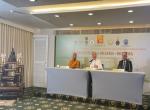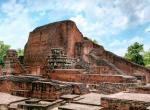Culture and cultural institutions in India have begun to bear the brunt of official apathy. In a strange turn of events the present government has reduced the allocation for 2012-13 for the Ministry of Culture. It is indeed unimaginable that in a country like India which retains an unparalleled cultural and civilisational continuity, the government of the day refuses to see the larger role that a Ministry of Culture can actually play in disseminating and preserving India’s civilisational repositories.
The Parliamentary Standing Committee on Culture in its Report on Demands for Grants – 2012-13 of Ministry of Culture (May 2012) has highlighted this aspect and brought to notice the various discrepancies and anomalies that have been allowed to creep into the entire edifice of the administration of culture in India. The Committee noted that against the projected demand of Rs. 2916.43 crore , the Ministry of Culture has been allocated only Rs.864.00 crore for 2012-13 an amount that is less than 1/3 of what was proposed by the Ministry.’ In no uncertain term it noted ‘the apathy of the Government towards the cause of preservation and promotion of our ancient culture.’
The Committee further observed that even during the XIth five year plan Art and Culture ‘got a share of only 0.16% of the total central plan allocation of the Government of India’ and argued that the Ministry of Culture ‘certainly deserves a better treatment in allocation of funds in view of its importance’ and has urged that the concerned disbursing ministry and the body such as the Finance Ministry and the Planning Commission be sensitized to ‘appreciate the contribution of art and culture to our nation’s life.’ At a time when cultural diplomacy and the wielding of soft power is assuming greater importance as instruments of internal relations it is bewildering to note this piping down of resources for culture.
Similarly the 2012-13 budget for the premier body for cultural diplomacy and outreach, the Indian Council for Cultural Relations (ICCR), has been kept at the same as for the year 2010-11. This has been done at a time when ICCR has expanded its activities within and outside India and has been constantly demanding an enhanced budgetary allocation in order to meet its international commitments. The Parliamentary Standing Committee on External Affairs in its Report on Demands for Grants (2012-13) (May 2012) has observed that ‘during the last three years the ICCR has been allocated almost the same fund of Rs. 150 crores against their demand ranging from Rs.166 crores to Rs. 252 crores this year.’ The Committee has thus pointedly told the Government that with ‘such insufficient fund allocation ICCR will not be able to achieve the objectives of cultural diplomacy’ with any meaningful impact. It also expressed its ‘displeasure over long pendency of opening up of Indian Cultural Centre at Washington’ and directed the Ministry to identify land/space for the proposed centre and expedite the process.
The state of Museums in the country, especially the National Museum and other units related to heritage conservation and preservation is not bright either and seems to require urgent and innovative interventions. For example it was noted that the expenditure has been ‘less in those areas which are critical for preservation and propagation of culture and invariably [required] more funds such as [Archeological Survey of India] ASI, Museums and archives.’
Some stark facts regarding the state of cultural affairs also emerge from a scrutiny of the report which gives lie to the view that much has been done over the last few years for Indian culture. A huge gap seems to be existing ‘between the sanctioned strength and assessed strength’ in ‘almost all categories of staff and officers in ASI.’ The Committee did observe that such a situation is ‘certainly telling upon the work relating to preservation and protection of our monuments.’ The staff position especially in the Science and Epigraphy section of the ASI was particularly alarming; especially the Epigraphy branch immediately needs subject matter specialists or faces risk of gradual decay and eventual closure – an unthinkable situation for a country like India, rich in epigraphical sources and material.
In fact, a large number of vacancies continue to exist in cultural institutions across the country. The Ministry has not been able to fill up these and a number of posts have actually lapsed due to delay in the recruitment process. The Committee wondered how with so many posts lying vacant at various levels these premier institutes succeeded in functioning at all.
The Committee was also at a loss to note that the nodal ‘Institute of Archaeology which was set up in 1985’ continues to remain ‘nonfunctional for want of requisite staff till date.’ Its earlier recommendation that ASI be developed as a Scientific and Technical Department has also not seen any concrete action taken by the Ministry of Culture as well as ASI. Referring to its 91st report on this matter the Committee said that the ASI has failed to develop itself not merely ‘as an administrative body but also as a spearhead for consolidating the scientific discipline of archaeology in the country’ it called on the central archaeological body to ‘reinvent itself, not merely as an administrative wing of the Government, but as an agency for protecting and safeguarding our national heritage, which involves a lot of scientific and technical work.’ Unless this is done the very raison d’être of the organisation stands to be defeated.
The Committee also found that museums were not being properly managed and were faced with a number of issues such as ‘large number of posts lying vacant for years, lack of personnel with required training/skill, poor upkeep/maintenance, galleries being closed for longer period’ and a lack of inter-agency coordination. In any case it found the reasons proffered as ‘purely technical, vague and repetitive.’
In another huge gaffe the Acquisition Committee at the premier National Museum in New Delhi has also not been revived due to shortage of space thus holding up for an indefinite period the entire process of art acquisition – which is a crucial lifeline for all museums. The Committee found the shortage of space argument rather ‘specious.’ The work of documenting built heritage and sites undertaken by the National Mission on Monuments and Antiquities (NMMA) also seems to be advancing slowly. During the 11th Five year plan the NMMA could ‘document only 80000 built heritage and sites out of 4 lakh estimated.’ At such a pace it will take another 20 years to complete the entire documentation process thereby delaying the formation of a crucial master repository of heritage sites structures in India. The Committee highlighted this as well.
In this connection it may be mentioned that it asked the Government to show greater initiative in preserving our historical sites and directed it to restore and preserve the temple of Dev Varunark in Bhojpur district of the state of Bihar and place the idols of the temple. This magnificent 14th century temple complex with ruins of many deities and inscriptions of the King of Magadh is being neglected with the idols lying in a terrible state of neglect.
One of the most serious and damning finding of the Committee was that the physical verification of objects at the National Museum New Delhi and the National Gallery of Modern Art had not been done since 2003 and 2000 respectively, ceding space to ‘unscrupulous elements’ to have a field day. The Committee has argued that if the verification is ‘not done for a longer period,’, ‘fixing the responsibility will be a daunting task’ and has recommended that ‘for the sake of preserving the invaluable treasures, the Government should take immediate steps to conduct physical verifications’ of artifacts in these leading institutions of art and culture.
Acceding that there is serious shortage of ‘cultural managers and technical experts’ in the country the Committee called for the Government to seriously devise ‘suitable courses’ that need to be introduced in the academic institutions and universities at various levels.’ This of course requires an imaginative academic approach and thinking – which is lacking in the present educational planning in the country.
The picture does not really inspire optimism, and at this rate all our symbols of Indian history and culture appear to be seriously threatened. It is difficult to fathom the present Government’s apathy and inertia towards the discovery, preservation and promotion of Indian culture. Its professed cultural aficionados have been repeatedly ignoring the imperative of creating a vibrant Ministry of Culture that shall work with a civilisational perspective in mind. Burdened with a myopic vision of history, ceaselessly engaged in deconstructing Indian nationhood our present policymakers do not seem to have the inclination to seriously look into these vital aspects of national identity and ethos.
The Parliamentary Committee has indeed done a service to the nation by bringing to light the acute official apathy that Indian culture faces in India itself. It is a state of affairs that calls for urgent intervention and rectification. Is anyone listening?
Published in Folks Magazine 7th June 2012









Post new comment